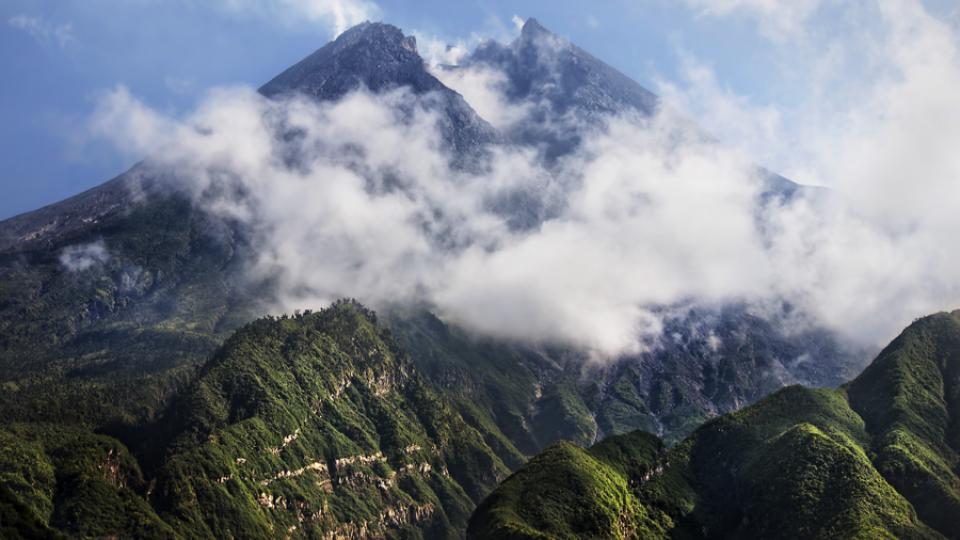Rising to 2,968 meters, Mount Merapi is Indonesia’s most active volcano and one of the world’s most dangerous—records of its eruptions date back to 1006 CE, with almost one hundred documented eruptions since that time. The celebrated volcano is a key feature of the sacred landscape of central Java and a vital component of Javanese history and culture. Located in close proximity to the renowned cities of Yogyakarta and Surakarta and the ancient ruins of Borobudur and Prambanan, Merapi also contributes to the tourism portfolio of central Java; the area has long been a popular attraction for both domestic Indonesian and international tourists, who hike the mountain to view the sunrise across eastern Java.

View of the Mount Merapi volcano
View of the Mount Merapi volcano
2013 Jimmy McIntyre
 This work is licensed under a Creative Commons Attribution-NonCommercial-ShareAlike 3.0 Unported License.
This work is licensed under a Creative Commons Attribution-NonCommercial-ShareAlike 3.0 Unported License.
In 2004, the government of Indonesia declared Mount Merapi to be the nation’s thirty-ninth national park, in part to protect the water catchment areas, rivers, and water supply for the adjacent urban areas. However, the designation of Merapi as a national park was greeted with protests from the villagers and farmers on and around the mountain, who felt that they had been excluded from the decision-making process and that their right to use the forest resources in the region would be lost once the park was created. Despite the implementation of a zoning system that permits the villagers regulated access to some parts of the park, local residents have continued to protest, receiving legal assistance from WALHI (The Indonesian Forum for Environment—Friends of the Earth), one of Indonesia’s most prominent conservation organizations.
Resistance to the development of Merapi as a national park reflects widespread Indonesian suspicion towards national parks programs. During the Suharto regime (1967–98), national parks were regularly havens for illegal logging and mining operations, while the creation of parks often facilitated the central government’s control over Indonesia’s natural resources by providing a justification for removing residents from these areas. In the post-Suharto era, “reformasi” policies devolved control over natural resources to the regional leaders, who subsequently promoted the expansion of national parks in their districts in the hopes that parks would bring prestige and revenue from tourism and research. However, illegal mining and logging operations have continued to degrade Indonesia’s national parks, while the removal of people persists as a basic goal of park management. In the case of Merapi, sand mining—the result of concessions granted by the local government—have had the most damaging impact on Merapi’s environment; nevertheless, this practice has been allowed to continue, while the collection of forest products by the local villagers has been targeted for control instead.

Tourists and a villager at Merapi National Park
Tourists and a villager at Merapi National Park
2013 Steven Rodriguez
 This work is licensed under a Creative Commons Attribution-NonCommercial-ShareAlike 3.0 Unported License.
This work is licensed under a Creative Commons Attribution-NonCommercial-ShareAlike 3.0 Unported License.
The recent history of Merapi’s eruptions, which have been responsible for the death and displacement of thousands of people, has further complicated the relationship between the government and local residents. Attempts to relocate villages from the most dangerous areas of the volcano have been unsuccessful due to the villagers’ socio-cultural ties to Merapi, but also as a consequence of their distrust of the government. In November 2010, Merapi experienced its most violent convulsions since 1872, yet local residents were unwilling to heed official calls for evacuation in part because of the plans for the national park—the villagers believed that the evacuation was a government tactic designed to get residents to leave in order to confiscate their land for the park. The conflicts between local, regional, and national stakeholders over Merapi’s status as a national park reveals the difficulties of creating national parks in densely populated regions of Indonesia, but it also exposes how corruption has damaged the credibility of Indonesia’s national parks and threatens their future development as locations for nature conservation and national identity.
How to cite
Rodriguez, Steven. ““I Prefer to Die on the Mountain”: Local Resistance to National Park Development on Mount Merapi.” Environment & Society Portal, Arcadia (2014), no. 1. Rachel Carson Center for Environment and Society. https://doi.org/10.5282/rcc/5657.
ISSN 2199-3408
Environment & Society Portal, Arcadia
 This work is licensed under a Creative Commons Attribution-NonCommercial-ShareAlike 3.0 Unported License.
This work is licensed under a Creative Commons Attribution-NonCommercial-ShareAlike 3.0 Unported License.
2013 Steven Rodriguez
This refers only to the text and does not include any image rights.
Please click on the images to view their individual rights status.
- Cochrane, Janet. “National Parks in Indonesia: An Alien Construct.” In Tourism and National Parks: International Perspectives on Development, edited by Warwick Frost and C. Michael Hall, 211–24. London: Routledge, 2009.
- Donovan, Katherine. “Doing Social Volcanology: Exploring Volcanic Culture in Indonesia.” Area 42 (2010): 117–26.
- Dove, Michael R. “Perception of Volcanic Eruption as Agent of Change on Merapi Volcano, Central Java.” Journal of Volcanology and Geothermal Research 172 (2008): 329–37.
- Schlehe, Judith. “Reinterpretation of Mystical Traditions: Explanations of a Volcanic Eruption in Java.” Anthropos 91 (1996): 391–409.
- Voight, B., E. K. Constantine, S. Siswowidjoyo, and R. Torley. “Historical Eruptions of Merapi Volcano, Central Java, Indonesia, 1768–1998.” Journal of Volcanology and Geothermal Research 100 (2000): 69–138.








